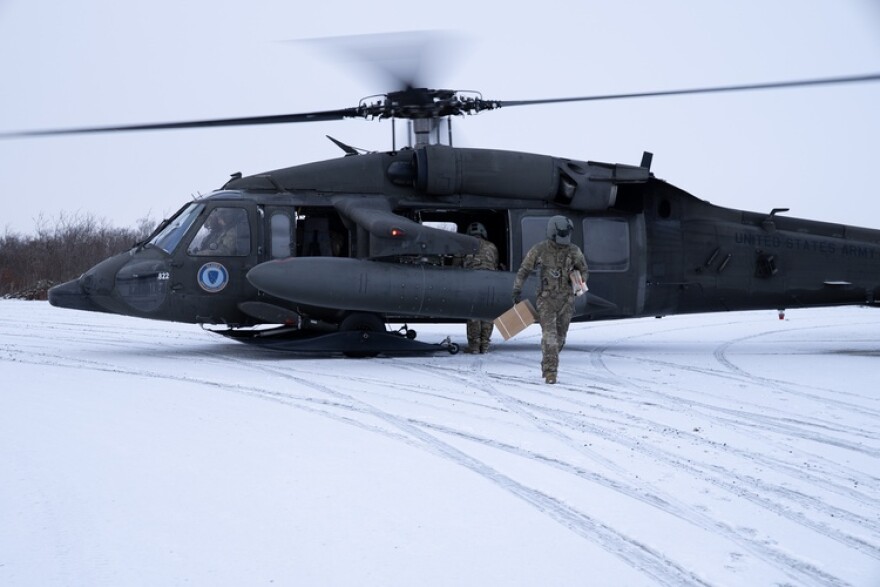Officials with the Alaska National Guard said they are preparing and training a response force of 100 service members to deploy to Washington D.C. and support civil authorities, as directed by the Pentagon and Gov. Mike Dunleavy.
The update on Tuesday from Maj. Gen. Torrence Saxe, Adjutant General of the Alaska National Guard and Commissioner of the Alaska Department of Military and Veterans Affairs, was in response to a letter from state legislators on the Alaska Joint Armed Services Committee. The lawmakers raised concerns around the implications of a Pentagon directive to Alaska to prepare 350 National Guard personnel for rapid deployment for “civil disturbance operations.”
In his letter, Saxe said Gov. Mike Dunleavy requested that the force be deployed to Washington D.C. to join a joint federal task force in March of 2026.
A spokesperson with the governor’s office confirmed Thursday the request came from the U.S. Secretary of the Army and Dunleavy approved it.
“Governor Dunleavy approved the request because he wants to help the Trump Administration restore public trust and improve the quality of life in the nation’s capital,” said Jeff Turner, the governor’s director of communications, by email.
But the request may turn out to be moot, after a federal judge temporarily blocked the deployments to Washington D.C. on Thursday, declaring the use of troops is likely unlawful. There is a pause on the order until Dec. 11, which gives the Trump administration time to appeal.
Turner declined to comment on the federal ruling.
Saxe said in the letter that 100 Alaska service members are being trained to align with “national level requirements.”
“The team will consist of Alaska Army and Air National Guard personnel trained in mission sets that may include site security, roadblocks and checkpoints, civil disturbance control, critical infrastructure protection, and personnel security,” Saxe wrote. “All training activities are integrated into existing unit schedules and do not alter the organization’s operational commitments.”
The Alaska National Guard is currently active in the disaster relief effort after Typhoon Halong devastated communities of Western Alaska, with an estimated 200 service members deployed there, officials said.
Saxe repeated that the development of this “quick response force” is not new for the National Guard, and it will be structured to “respond quickly to protect lives, property, and critical infrastructure.”
“At the request of Alaska Gov. Mike Dunleavy, members of the Alaska NGRF (National Guard Response Force) will activate to Washington, D.C., in March 2026 to support Joint Task Force–District of Columbia, a federally coordinated effort that brings together National Guard elements, civic leaders, and partner agencies to enhance safety, stewardship, and community engagement,” he wrote.
Officials with the National Guard declined interview requests on Wednesday and Thursday.
In August, officials with the governor’s office said there were “no plans” to deploy the Alaska National Guard to Washington D.C., as reported by the Anchorage Daily News.
The Trump administration’s deployment of National Guard troops to primarily Democratic-led cities has been challenged and repeatedly blocked as illegal in federal courts. On Monday, a Tennessee judge barred the National Guard deployment to Memphis, and said it was only allowable if there was a rebellion or invasion. On Thursday, a federal judge temporarily ordered an end to the monthslong deployment of National Guard to Washington D.C. to tackle crime, declaring the use of troops as likely unlawful.
Rep. Andrew Gray, D-Anchorage and co-chair of the Alaska Joint Armed Services Committee, said he was grateful for the commissioner’s response and additional information on the specialized force, but remains concerned about the capacity and purpose of such a mission.
“It’s important to note that the American taxpayer will be paying their salary while they’re on this mission. They’ll be paying for their room and board,” he said. “So when the National Guard does a mission like this, we just don’t have unlimited money. So we are redirecting money away from training and work here in Alaska.”
Gray said while the Trump administration may have the authority to call the National Guard to Washington, a federal district, he remains concerned at military service members being deployed against civilians and used for police or immigration enforcement.
“Are these police departments saying that they’re overrun, that they’re unable to perform their law enforcement mission, that they need to have their force doubled, tripled, quadrupled in numbers?” he said. “Because that’s what’s happening.”
There are currently 2,866 National Guard service members enlisted in the state, with 1,676 in the Alaska Air National Guard and 1,190 in the Alaska Army National Guard.
Gray, a veteran of the Alaska National Guard who deployed to Kosovo in 2019, said he also worries about the erosion of trust and regard for the military doing these kinds of missions, and deploying against civilians.
“I love the U.S. military. I am proud of my service in the Alaska Army National Guard,” he said. “I think this is going to hurt the military’s standing in the public’s mind. I think that this is going to cause folks to lose some of the admiration that has been so foundational in our country for the military. Our country has long admired, respected and praised its military, and the moves that we are seeing, directed by Secretary Pete Hegseth and the President of the United States are going to lose our military’s standing, not only internationally, but domestically as well.”
Gray said he has requested a meeting with Saxe, and is asking for continued public communication and transparency as the quick response force is developed.

